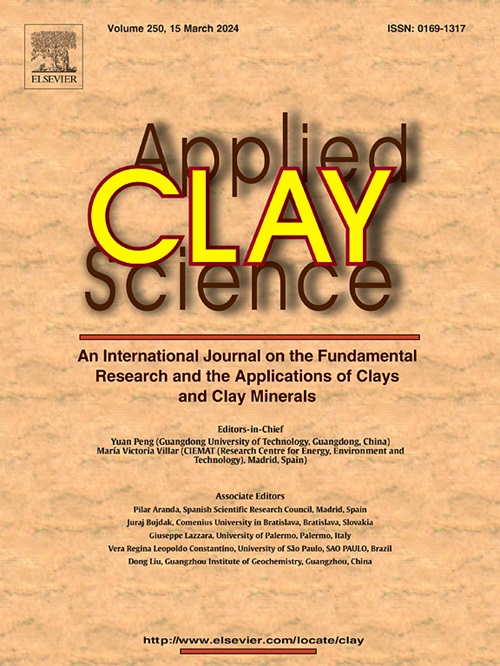Eco-friendly design of active montmorillonite nanofillers for reinforcing the anti-corrosion property of epoxy coating
IF 5.8
2区 地球科学
Q2 CHEMISTRY, PHYSICAL
引用次数: 0
Abstract
In this work, a montmorillonite (MMT)-based composite coating with long-term corrosion protection for mild steel was prepared. This composite coating incorporated the montmorillonite@polydopamine@cerium phytate (MMT@PDA@PACe) nanofiller, prepared by the easily layer-by-layer surface assembly method. Electrochemical impedance spectroscopy (EIS) and surface morphology studies showed that the prepared composite coating exhibited long-term protective performance, self-healing performance, and good integrity. In this instance, on the one hand, two-dimensional (2D) MMT could block the path of corrosive media penetrating the coating. Also, organic modification of PDA and PACe could enhance the dispersibility and compatibility of inorganic MMT fillers, thus enhancing the coating barrier effect. On the other hand, composite materials could perceive corrosion reactions and actively release corrosion inhibitors to improve corrosion resistance performance further. The coating's self-healing performance and release characteristics of corrosion inhibitors were investigated by the EIS and inductively coupled plasma optical emission spectrometer (ICP-OES) tests. Moreover, after 60 d immersion, the |Z|0.01 Hz value of the 0.5 wt% MMT@PDA@PACe composite coating was over 109 Ω·cm2, which is 3 orders of magnitude higher than that of the bare coating. Simultaneously, the adhesive force studies were applied to the composite coatings, and the results illustrated that the coating had the highest dry conditions adhesion force with 5.43 MPa and the lowest adhesion force loss rate at 14.1 % after 30 d of immersion.

活性蒙脱土纳米填料的环保设计,增强环氧涂料的防腐性能
本文制备了一种具有长期防腐性能的蒙脱土基复合涂层。这种复合涂层包含montmorillonite@polydopamine@植酸铈(MMT@PDA@PACe)纳米填料,通过简单的逐层表面组装方法制备。电化学阻抗谱(EIS)和表面形貌研究表明,制备的复合涂层具有长期保护性能、自修复性能和良好的完整性。在这种情况下,一方面,二维(2D) MMT可以阻断腐蚀介质穿透涂层的路径。同时,对PDA和PACe进行有机改性可以增强无机MMT填料的分散性和相容性,从而增强涂层阻隔效果。另一方面,复合材料可以感知腐蚀反应并主动释放缓蚀剂,进一步提高耐腐蚀性能。采用EIS和电感耦合等离子体光学发射光谱仪(ICP-OES)测试了涂层的自愈性能和缓蚀剂的释放特性。此外,0.5 wt% MMT@PDA@PACe复合涂层浸泡60 d后,|Z|0.01 Hz值大于109 Ω·cm2,比裸涂层提高了3个数量级。同时,对复合涂层进行了附着力研究,结果表明,涂层在干燥条件下的附着力最大,为5.43 MPa,浸泡30 d后附着力损失率最低,为14.1%。
本文章由计算机程序翻译,如有差异,请以英文原文为准。
求助全文
约1分钟内获得全文
求助全文
来源期刊

Applied Clay Science
地学-矿物学
CiteScore
10.30
自引率
10.70%
发文量
289
审稿时长
39 days
期刊介绍:
Applied Clay Science aims to be an international journal attracting high quality scientific papers on clays and clay minerals, including research papers, reviews, and technical notes. The journal covers typical subjects of Fundamental and Applied Clay Science such as:
• Synthesis and purification
• Structural, crystallographic and mineralogical properties of clays and clay minerals
• Thermal properties of clays and clay minerals
• Physico-chemical properties including i) surface and interface properties; ii) thermodynamic properties; iii) mechanical properties
• Interaction with water, with polar and apolar molecules
• Colloidal properties and rheology
• Adsorption, Intercalation, Ionic exchange
• Genesis and deposits of clay minerals
• Geology and geochemistry of clays
• Modification of clays and clay minerals properties by thermal and physical treatments
• Modification by chemical treatments with organic and inorganic molecules(organoclays, pillared clays)
• Modification by biological microorganisms. etc...
文献相关原料
公司名称
产品信息
麦克林
phytic acid (PA)
麦克林
tris (hydroxymethyl) aminomethane (Tris)
麦克林
dopamine hydrochloride (DA)
麦克林
MMT
阿拉丁
cerium nitrate hexahydrate (CeNO3·6H2O)
 求助内容:
求助内容: 应助结果提醒方式:
应助结果提醒方式:


